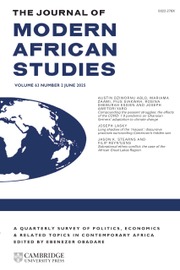Article contents
Regional Integration and the Crisis in Sub-Saharan Africa
Published online by Cambridge University Press: 11 November 2008
Extract
The appalling experience of most African countries has led many observers to conclude that the continent has now reached a critical stage in its development, and that a political, social, and economic ‘nightmare’ by the turn of the century cannot be ruled out.1 One pessimistic scenario suggests that even with fundamental improvements in domestic economic management, up to four-fifths of Africa's population in 1995 will be below the poverty line compared with three-fifths today.2 This is the context in which African leaders enunciated new development priorities in their 1980 Lagos Plan of Action, notably greater self-reliance and industrialisation geared to domestic markets. Outside the continent, a growing concern with dismal African prospects has generated two action programmes by the World Bank,3 while new guidelines have recently been produced in the European Community for supporting African development.4 Without exception, all of these appraisals see a major role for regional co-operation and economic integration.
- Type
- Articles
- Information
- Copyright
- Copyright © Cambridge University Press 1985
References
page 603 note 1 U.N. Economic Commission for Africa, ECA and Africa's Development, 1983–2008: a preliminary perspective study (Addis Ababa, 1983).Google Scholar
page 603 note 2 World Bank, Toward Sustained Development in Sub-Saharan Africa: a joint program of action (Washington, D.C., 1984), p. 9.Google Scholar
page 603 note 3 World Bank, Accelerated Development in Sub-Saharan Africa: an agenda for action (Washington, D.C., 1981).Google Scholar
page 603 note 4 European Community, The European Community and Africa (Brussels, 1984).Google Scholar
page 604 note 1 See Oman, Charles, New Forms of International Investment in Developing Countries (Paris, 1983),Google Scholar and Buckley, Peter, ‘New Forms of International Cooperation: a survey of the literature with special reference to North-South technology transfer’, in Aussenwirtschaft (St. Gallen, Switzerland), 38, 2, 1983, pp. 195–222.Google Scholar
page 605 note 1 See U.N. Economic Commission for Africa, Proposals for Strengthening Economic Integration in West Africa (Addis Ababa, 1984).Google Scholar
page 606 note 1 Source: World Bank, Toward Sustained Development in Sub-Saharan Africa, pp. 57–8.
page 607 note 1 Source: as for Table 1.
page 609 note 1 See Robson, Peter, ‘The Mano River Union’, in The Journal of Modern African Studies (Cambridge), xx, 4, 12 1982, pp. 613–28.Google Scholar
page 613 note 1 For a full discussion of this case, see ‘Senegambia: economic and monetary union’, in Robson, Peter, Integration, Development and Equity: economic integration in West Africa (London, 1983), pp. 124–40.Google Scholar
page 614 note 1 Patrick, and Guillaumont, Sylviane, Zone franc et dévelopment africain (Paris, 1983), ch. 10.Google Scholar
page 615 note 1 Robson, Integration, Development and Equity.
page 616 note 1 The corresponding group in Central Africa has so far made little progress.
page 618 note 1 U.N. Economic Commission for Africa, Report of the ECA Mission on the Evaluation of UDEAC (Addis Ababa, 1982).Google Scholar
page 621 note 1 See, for instance, Donovan, D. J., ‘Macroeconomic Performance and Adjustment under Fund-Supplied Programs: the experience of the seventies’, in IMF Staff Papers (Washington, D. C.), 29, 1982, pp. 171–203.Google Scholar
page 621 note 2 Guillaumont and Guillaumont, op. cit.
page 621 note 3 Equatorial Guinea joined L'Union monétaire de l'Afrique centrale in January 1985, having previously been admitted to the U.D.E.A.C. São Tomé and Príncipe intends to join the U.M.A.C.
page 621 note 4 Report of the ECA Mission on the Evaluation of UDEAC, pp. 60–2.
- 4
- Cited by


